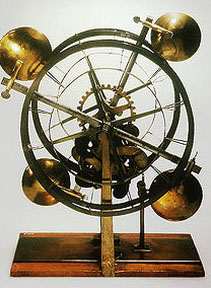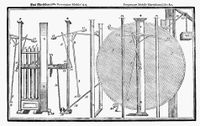Difference between revisions of "Perpetual Motion"
m (typo) |
(translation) |
||
| Line 1: | Line 1: | ||
| − | [[image: | + | [[image:perpetual motion.png|thumb]] |
| − | A ''' | + | A '''perpetual motion''' (lat: eternal movement) device is a hypothetical machine which is said to be able to produce work indefinitely without energy sources, or produces more energy than it consumes. Until today, no functioning perpetual motion device has been known of, although numerous lay persons, individual researchers, and pseudo-scientists have tried to construct such a device. |
| − | A great number of inventors claim they have built a perpetual motion machine, but none of them succeeded in proving this. | + | A great number of inventors claim they have built a perpetual motion machine, but none of them succeeded in proving this. The field of perpetual motion research is also haunted by a fair share of impostors. These persons will often avoid the term perpetual motion and rather describe their devices as 'converters'. |
| − | ==Classes of | + | Such a device, if working, will be inconsistent with today's knowledge of physics, especially with the law of energy conservation and Noether's theorem. |
| + | |||
| + | ==Classes of Perpetual Motion Devices== | ||
[[image:pmleonardodavinci.jpg|PM according to Leonardo da Vinci|left|thumb]] | [[image:pmleonardodavinci.jpg|PM according to Leonardo da Vinci|left|thumb]] | ||
| − | [[image:BesslerRad.jpg|PM Bessler | + | [[image:BesslerRad.jpg|PM Bessler Wheel|200px|thumb]] |
| − | From a theoretical point of view, these | + | From a theoretical point of view, these machines are classified into three categories based on which law of thermodynamics they violate: |
| − | * | + | *Perpetual motion device of the first category: This machine would show an efficiency of more than 100% (PM supporters will also call it 'overunity'). Such a device will be in violation of the first law of thermodynamics, the law of energy conservation, as it would produce energy from nothing. |
| − | *Perpetuum Motion device of the second | + | *Perpetuum Motion device of the second category: This machine will work cyclically and and will take the energy necessary from a heating bath. Such a device will be in violation of the second law of thermodynamics, since the total conversion of work into heat happens to be irreversible. Heat pumps therefore may not be seen as a second category PM. |
*Perpetuum Motion device of the third kind: A machine that runs indefinitely without doing any work. The idea is that, if friction is completely removed, such a machine might run forever. And while it is impossible to achieve, it is however possible to come pretty close. Such devices have actually useful appliances e.g in the construction of flywheels. | *Perpetuum Motion device of the third kind: A machine that runs indefinitely without doing any work. The idea is that, if friction is completely removed, such a machine might run forever. And while it is impossible to achieve, it is however possible to come pretty close. Such devices have actually useful appliances e.g in the construction of flywheels. | ||
Revision as of 13:08, 25 February 2011
A perpetual motion (lat: eternal movement) device is a hypothetical machine which is said to be able to produce work indefinitely without energy sources, or produces more energy than it consumes. Until today, no functioning perpetual motion device has been known of, although numerous lay persons, individual researchers, and pseudo-scientists have tried to construct such a device.
A great number of inventors claim they have built a perpetual motion machine, but none of them succeeded in proving this. The field of perpetual motion research is also haunted by a fair share of impostors. These persons will often avoid the term perpetual motion and rather describe their devices as 'converters'.
Such a device, if working, will be inconsistent with today's knowledge of physics, especially with the law of energy conservation and Noether's theorem.
Classes of Perpetual Motion Devices
From a theoretical point of view, these machines are classified into three categories based on which law of thermodynamics they violate:
- Perpetual motion device of the first category: This machine would show an efficiency of more than 100% (PM supporters will also call it 'overunity'). Such a device will be in violation of the first law of thermodynamics, the law of energy conservation, as it would produce energy from nothing.
- Perpetuum Motion device of the second category: This machine will work cyclically and and will take the energy necessary from a heating bath. Such a device will be in violation of the second law of thermodynamics, since the total conversion of work into heat happens to be irreversible. Heat pumps therefore may not be seen as a second category PM.
- Perpetuum Motion device of the third kind: A machine that runs indefinitely without doing any work. The idea is that, if friction is completely removed, such a machine might run forever. And while it is impossible to achieve, it is however possible to come pretty close. Such devices have actually useful appliances e.g in the construction of flywheels.
Examples
- Hydrino
- Joe-Cell
- Perendev-Group
- Steorn
- Devices of Leslie Szabó
- Testatika
- Concepts of Claus Wilhelm Turtur
- Wasserauto
- Felix Würth AG
Weblinks
- http://en.wikipedia.org/w/index.php?title=Perpetual_motion
- http://en.wikipedia.org/w/index.php?title=History of perpetual motion machines
- The Museum of Unworkable Devices
- Flywheels in the wikipedia
Versions of this article in other languages
- deutsch: Perpetuum Mobile

